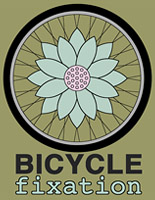"Look at this bozo who thinks hes a rider!" Among the passing cars was a team of bicycle racers. They were ascending a five mile incline on the shoulder of which I was prying my flattened rear tire from the rim of my one-speed bike, keeping my tie tucked in my shirt. "Nothing like dressing for the weather," said one sweaty champion. "Get the right threads, man." None seemed impressed that I was working with proper tools to handle my own emergency. They apparently saw my attire as the reason I was immobile on the side of their road to glory. They were dressed in psychedelic, skin tight uniforms. The only African-American among them laughed his scorn: "Ha, ha! You need decent wheels and spats."
I couldn't disagree more.
Ride to Work, Work to Ride
Regardless of what the pros wear, I will stick to generic slacks and button down shirts. I often wear two
shirts at once in order to carry books or a camera between cloth against my chest. When choosing
cycling clothes, I consider what works for me rather than what is trendy.
The sneering peloton was probably against my bike as well as my clothes. I was pedaling a salvaged childs bike with a solid steel two-and-a-half foot long seat post. It all made me feel alone as I pumped up my inner tube, rotated it in front of my face to detect its punctures tiny air blast, and set about scraping, gluing, and patching it. However, it gave me some solace that someone with unfashionable dress rather than someone with darker skin could be deemed the outsider.
Since that day my personal fleet has grown to include, among others, a 21-speed. My kind of pedaling is for transportation, not sport. I carry cameras, books, clothes, tools, and food in pannier bags. I ride to the store, to classes, to visit people, to work--I have so much to carry that I do not want anything either on my vehicle or on my body that is not truly part of my task. I wear perma-press slacks and plain white oxford cloth shirts. Those red, orange, green, or yellow cycling jerseys decorated with corporate logos are usually accompanied by computerized handle-bar speedometers. Should I worry about exceeding the speed limit?
I feel unworthy of wearing racing clothes. People pedaling in trim synthetic suits must take care of their jobs in a more tidy place and time than I do mine. They manage to perfect their mobility scientifically. Some wear electrodes attached to their chests to monitor their heart rates. They zoom ahead of me even when I do not have a flat tire. When I pedaled from LA to San Diego to photograph a fiftieth anniversary, my racing acquaintances had said it would take nine hours. I did not believe them so I left a day early. I was right. It took me sixteen hours.
Who Owns You Today?
Those commercial cycling clothes seem to represent something not quite right. They are intended to
appear fast even when their wearer is standing still. They are shown in cycling magazines with blazing
headlines implying conquest: "Burn, Beat, Blast!" The helmets, gloves, and flame-emblazoned armor all
bespeak a soldier-like dominance of nature and of fellow cyclists. The mountain bike industry is based on
the idea that people want to glide unfeelingly over rough terrain. My bikes are made for the marvelous
invention of pavement. My legs are adequate for allowing me ambulatory contact with dirt and brush,
which interests me too much to want to glide over it.
Helmets certainly have a purpose; tights and jerseys help the racer on his hard narrow seat. At the same time, they expose you more to sunburn than do street clothes, as well as to the herd mentality. My concern is not with whether to wear bicycle clothing at all, but with whether to allow a corporation or a culture to tell me what kind of clothes to wear.
Just Because It Looks Good in the Ad....
Todays "bicycle shoes" do not work well in toe clips. Somebody gave me a beautiful new pair of
bicycling shoes which the sales person had claimed would work fine in toe clips. However, the sides had
holes worn through after just one week of my pedal commuting. I returned to my habit of pedaling in
Red Wing work shoes. A shoe repair man eventually patched the uppers of the "real" cycling shoes with
extra thick leather. The cycling shoes are still less comfortable than the Red Wings, however, for they
have plastic inner walls and make my feet sweat. Also, there is almost no way to keep feet dry in the
rain. Neoprene socks help. I do not mind getting my feet wet, however, when my bags contain dry
loafers.
A friend of mine came across a pair of those black lycra shorts at a garage sale and gave them to me five years ago. I have not tried them on yet because I am afraid they will exaggerate my uniquely thin physique. I have so many old clothes that I can always wear some of them pedaling downtown to a photo shoot on a rainy day. I throw away the wet garb when I arrive at my job and change into a dress suit brought in plastic bags. I bring another set of old clothes to change back into for pedaling home. Pannier bags hold a lot.
I may never win a race. That is okay, though. I don't have anything to wear to the party.

